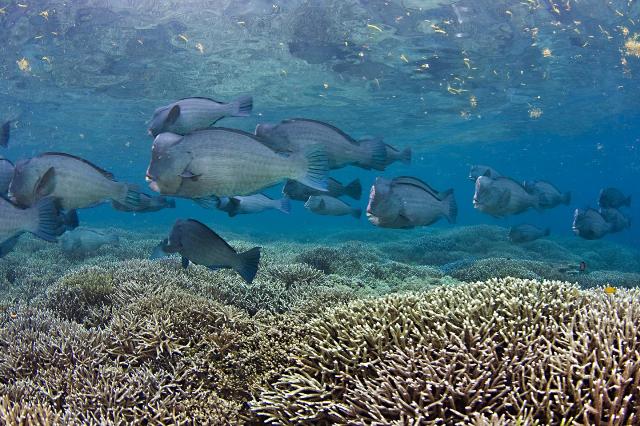Nov 18 2014
Leading coral reef scientists in Australia and the USA say there needs to be a new approach to protecting the future of marine ecosystems, with a shift away from the current focus on extinction threat.
 These are a giant humphead parrotfish: a species not regarded at risk of extinction, but one which has suffered severe decline. Credit: Image: JP Krajewski
These are a giant humphead parrotfish: a species not regarded at risk of extinction, but one which has suffered severe decline. Credit: Image: JP Krajewski
"Extinction is the final endpoint, but coral reefs are in deep trouble long before we get to that point. We need to take action much earlier," says Professor David Bellwood from the ARC Centre of Excellence for Coral Reef Studies (Coral CoE) at James Cook University.
"The goal should be to maintain reefs that can support corals, fish and humans" Professor Bellwood says.
In a world first study published in the journal, Current Biology, researchers tested the concept of 'double jeopardy', which is widely used to assess extinction risk. It is based on the assumption that the risk of extinction is greater if a species has both a small geographic range and low numbers.
The researchers counted the numbers of individuals of more than 400 species of fishes and corals across a 10,000km swath of the Pacific Ocean, from Indonesia to French Polynesia.
Professor Terry Hughes from the Coral CoE says they found no relationship between each species abundance' and its geographic range. To the contrary, the researchers found that some species with a small range had large numbers while some with a vast range spanning the Indo-Pacific Ocean were quite rare. The widely held assumption of double jeopardy is false.
"Our findings call into question the growing practice of assessing extinction risk of coral reef species without knowing how many of them are out there," says Professor Hughes. This is the first study to systematically count corals and reef fishes at a geographic scale".
The researchers argue that coral reef systems are threatened long before individual species are in danger of extinction. They say extinction threat is a poor approach to take to ensure the future of coral reefs.
"Many species on coral reefs are critically important for maintaining ecosystem health. Many reefs are in serious decline, even if the chances of individual species going extinct are slim."
Professors Bellwood and Hughes argue that the criteria for the IUCN threatened species Red List, used to assess extinction threat, are inappropriate for widespread marine species.
"The vast majority of marine plants and animals are comparatively resistant to global extinction because of their high rates of reproduction, ability to disperse widely, and huge geographic ranges which span up to tens of millions of square kilometres," Professor Hughes says.
"Rather than guessing at which species are threatened, we need a focus on local action to avert or recoup the loss of ecosystem function caused by habitat destruction and severe depletion of key species," Professor Hughes says.
Professor Bellwood says "This paper calls for caution when identifying species at risk of extinction on coral reefs. It highlights the potential weaknesses in current approaches and offers an alternative approach where species are valued for the services they provide for both reefs and humans".